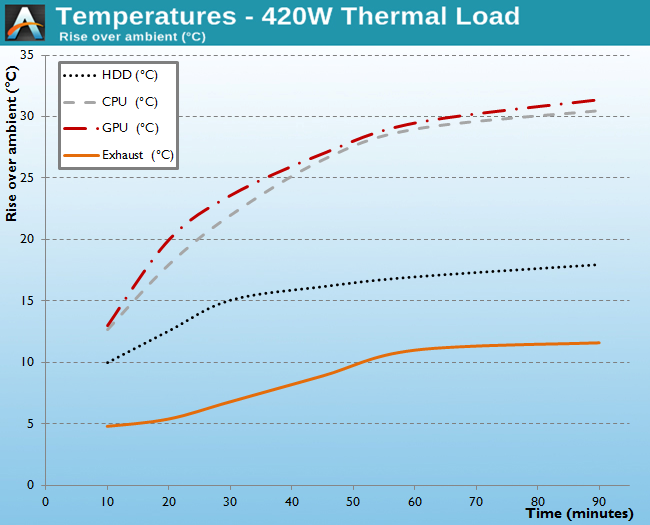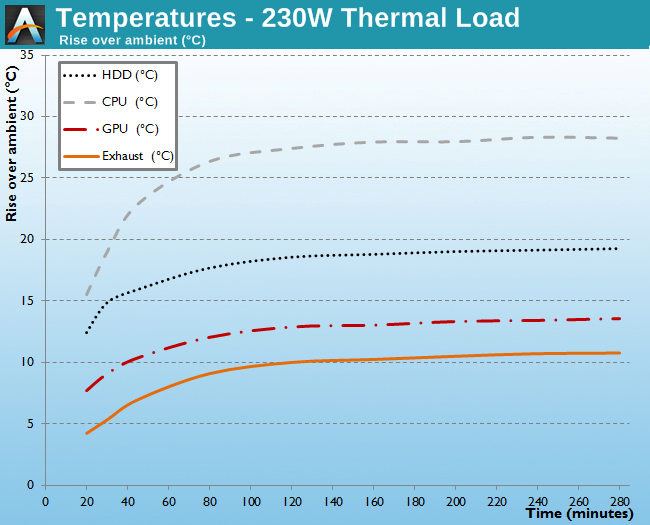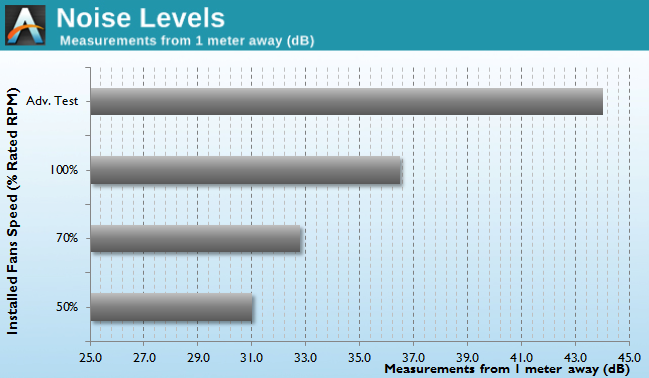Corsair Carbide Air 240 Case Review
by E. Fylladitakis on August 15, 2014 6:00 AM EST- Posted in
- Cases/Cooling/PSUs
- Corsair
- ATX
- Case
- Carbide
Test Setup
Professional testing requires the emulation of real-world situations but with repeatable results; thus, a perfectly controllable test setup and environment are required, especially for comparable results. Testing the thermal performance of any case with a typical real-world setup technically limits the comparability of the results to this setup alone, as an active system interacts with its environment and the change of a single component would alter myriads of variables. For our case reviews, we developed synthetic loads that emulate the thermal output of real systems, but these are passive, steady and quantifiable loads. This allows us to test the thermal capabilities of the case alone, as if it would have to deal with the entire thermal load by itself, regardless of what system an end user might install in it.
Laboratory data loggers are used to monitor the PT100 sensors and control the safety relays, which are fully accessible via our custom software. We have created three such loads, and we'll use the Micro-ATX load for this case. The Micro-ATX version simulates a 180W CPU, 40W VRM, 20W RAM, and 1 × 120W GPU card thermal load. Finally, two 3.5" HDD dummy loads have also been installed, with each of them converting 30W of electrical power to thermal. Note that the total load is generally more important than the individual elements, and the total thermal load of the Micro-ATX test setup is up to 420 Watts. As such, the thermal load is very high and only the best of cases will be able to handle it for more than a few minutes. For comparison purposes, we are also performing a test with a thermal load of 230W by reducing the CPU load to 90W, removing one disk load and using a low-profile, 50W version GFX load.
Thermal testing is performed with all of the case's stock fans operating at maximum speed. Standard noise testing has been performed with a background noise level of 30.4dB(A). Advanced noise testing is also being performed, in order to assess the ability of the case to dampen the noise of the components installed inside it. This includes the installation of two noise-generating sources (strong fans) inside the case, one positioned approximately over the first expansion slot and one over the CPU area, which generate ≈ 44.2 dB(A) when unobstructed. During the advanced noise test, all stock cooling options of the case are disabled.
Results and Discussion
As we expected from a case designed for ventilation, and despite its relatively compact size, the Carbide Air 240 displays exceptional thermal performance, significantly superior to that of the Mini-ITX Obsidian 250D. Although a direct comparison is not really possible, as the GPU load we use to test ATX cases is much higher, it would appear that the Carbide Air 240 has little to be jealous of Midi-ATX cases as well, delivering CPU and HDD temperatures that can easily rival cases such as the XFX Bravo 01 and Corsair's own Obsidian 450D.
The three stock cooling fans of the Carbide Air 240 are fairly weak, but that also has a positive effect on the acoustic performance of the case. With only the stock cooling fans installed, the Carbide Air 240 is a relatively quiet system, which can be made entirely quiet by simply connecting the fans onto the motherboard headers and leaving their speed control up to the BIOS. However, due to its design, the Carbide Air 240 cannot dampen the noise of the components installed inside it. Our testing revealed nearly zero noise-dampening capabilities, which is true of any case with so many openings on all sides.













63 Comments
View All Comments
bnjohanson - Saturday, August 16, 2014 - link
...in order to understand, consider believing it a must for car companies to still install cassette players in their newest models because..." I use mine for taping mixes of songs and backups for my CD's, etc. I constantly use it nearly everyday. Not to mention to just listen to a movie soundtrack while I am washing my car...Even on my home stereo system, I use the cassette player with some regularity. Sony Walkmans never have interested but with a car this huge, why isn't there one cassette-slot somewhere, even in the trunk? I just don't get it. I also drive motorcycles, smaller than my car, but it still has a cassette player."
ABSURD !
ZeDestructor - Saturday, August 16, 2014 - link
Well done, that gave me a good chuckle...notlurking - Saturday, August 16, 2014 - link
Your analogy is bad because you are comparing listening to media in a car with content creation.Someone needs to do the rips that you download. Those people need a 5.25 drive to get movies and music onto their NAS or PC.
If you want a car analogy, buy a small SUV (Corsair 240 is 15.75" deep!) without a trunk. Why do you need a trunk in your small SUV when everyone already uses Amazon to deliver things right to your door?
ZeDestructor - Monday, August 18, 2014 - link
External drives exist. As do full-size 5.25" eSATA/USB3.0/Firewire cases.Using the car analogy, that would be a trailer you would tow behind your small, fast Ferrari 458 for bringing extra tyres to trackdays.
notlurking - Monday, August 18, 2014 - link
If you are going to bring up eSata, then why do cases need 3.5" drives? Just use an external 3.5" eSata drive for those times you need to access those extra media files or games.RE: car
But the Corsair Air 540 is NOT a tiny Ferrari! It's 15.75" deep! It's the computer case equivalent of a small SUV. Look at the picture gallery. Fully filled, it has large empty areas.
Grok42 - Saturday, August 16, 2014 - link
There are very few cases without 5.25" bays, why must they all have them? If you like this case better than the hundreds of ones with a 5.25" bay maybe it's because not having a 5.25" bay frees up the case designers to build better designs. Every example you gave for using an optical drive I answered with "Internet". I have an external 5.25" drive that I use to do the odd OS install but I'm not even sure when I last did that.notlurking - Sunday, August 17, 2014 - link
Someone needs to do the rips that you download from the Internet. Not to mention that many downloads are sub-perfect quality that make me do my own rips for my NAS.Black Obsidian - Monday, August 18, 2014 - link
Was that same inane comment really worth making almost half a dozen times in the same comment thread?Others have already pointed out that such people are perfectly free to buy one of the many cases that DO have 5.25" drives, or buy this case and a USB optical drive. It's not a difficult problem to solve.
notlurking - Monday, August 18, 2014 - link
Yes, because of all the people making the same inane comment that everything is on the Internet a half a dozen times in the same comment thread.re: buy something else.
Then don't read reviews that are critical of anything. Is this facebook where only upvotes of products are allowed?
My criticism is for the remote chance that it gets back to Corsair and they improve their product.
flyingpants1 - Tuesday, September 2, 2014 - link
No need for discs anymore. I put everything on my phone, or USB stick, or external HDD.